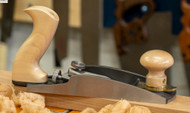Woodworking with the Bevel Up Smoothing Plane
Posted by Vic Tesolin on 30th Jul 2024

In the world of woodworking, having the right tools can make a world of difference in your projects. One tool that many woodworkers swear by is the bevel-up smoothing plane. This is the tool you need if you aim for that perfect, smooth finish on your woodwork. Let's dive into what makes it so special and how it can enhance your woodworking experience.
What is a Bevel-Up Smoothing Plane?
So, what exactly is a bevel-up smoothing plane? Unlike traditional hand planes, where the blade’s bevel faces down, this plane has the bevel facing up. This small change makes a big difference, allowing for a lower cutting angle, which is incredibly useful in various woodworking situations.
Key Features of the Bevel-Up Smoothing Plane
Blade Orientation: The most distinctive feature is its blade orientation. With the bevel facing up, it provides a lower effective cutting angle compared to the usual bevel-down planes. This is particularly handy when dealing with tricky grain patterns like flame birch or end grain.
Adjustable Cutting Angle: One of the best things about this plane is that you can adjust the cutting angle by changing the bevel angle of the blade. This means you can easily switch it up to handle different types of wood and grain orientations. Need a different cut? Just swap out the blade, and you’re good to go.
Mouth Opening: These planes usually come with an adjustable mouth opening. This feature lets you support the cut and helps prevent tear-out, giving you a smoother finish. Adjusting the mouth opening is great when moving from rough work to fine finishing.
Low Angle: The low angle of the blade is one of the key reasons woodworkers love bevel-up planes. It’s perfect for end grain work, allowing for clean, precise cuts that can be tricky with higher-angle planes.
Benefits of Using a Bevel-Up Smoothing Plane
Versatility: This plane’s ability to adjust the cutting angle makes it incredibly versatile. Whether you’re working with hard, dense woods or softer varieties, you can tweak the plane to suit your needs.
Ease of Use: Many find bevel-up planes easier to set up and adjust than traditional bevel-down planes. With a simpler design, there are fewer components to worry about, so you can spend more time on your work.
Simplicity: Because of its straightforward design, maintenance is a breeze. Cleaning, sharpening, and general upkeep are more straightforward, with fewer parts to manage.
Performance: Combining a sharp blade with the appropriate cutting angle produces super smooth finishes. This is especially noticeable when working on end grain or difficult grain patterns where other planes might struggle.
Common Uses for a Bevel-Up Smoothing Plane
Smoothing: As the name suggests, this plane excels at smoothing wood surfaces after they’ve been roughly shaped and dimensioned. The result? A fine, polished finish that showcases the wood’s natural beauty.
End Grain Work: The low cutting angle is ideal for planing end grain, giving you clean, precise cuts that enhance the overall quality of your piece.
The bevel-up smoothing plane is a versatile, user-friendly, and high-performing tool that every woodworker should consider adding to their collection. Whether you’re a seasoned pro or a hobbyist, mastering this plane can take your work to the next level. With its adjustable cutting angles, ease of use, and ability to produce smooth finishes, the bevel-up smoothing plane is a must-have for anyone serious about woodworking.
In order to understand, you must do. - Vic Tesolin

